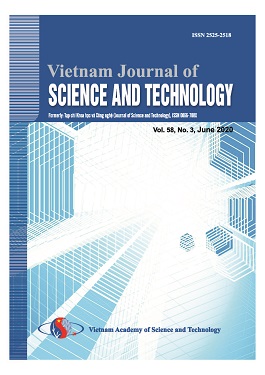Study on fluorination and hydrogenation in transparent conducting zinc oxide thin films
Author affiliations
DOI:
https://doi.org/10.15625/2525-2518/58/2/14083Keywords:
Transparent conducting oxide, ZnO thin films, fluorination, hydrogenation, magnetron sputteringAbstract
Fluorination and hydrogenation are known as two methods for enhancing crystalline structural and electrical properties of ZnO material. The ZnO thin films normally require a low resistivity and a high transmittance for using as high-performance transparent electrodes in optoelectronic applications. In this study, we report successful preparation of fluorinated and hydrogenated ZnO thin films (FZO and HFZO) by using d.c. magnetron sputtering technique. The hydrogenation was carried out by depositing the films in hydrogen plasma atmosphere, while a highly-sintered body of ZnO and ZnF2 compound was employed as a sputtering target for the fluorination. The results show that the strong improvements in carrier concentration, mobility and resistivity of the FZO and HFZO films as compared to the pure ZnO films. The carrier concentration increases to 2x1020 cm-3 which is mainly due to the hydrogenation. The effect combination of the fluorination and the hydrogenation is responsibility for enhancing the mobility up to 43 cm2/Vs. These results give rise to two-order reduction in resistivity, from 0.06 Ohm.cm (ZnO) to 7.5x10-4 Ohm.cm (HFZO), which can be a good choice for thin-film electrode application. In addition, the crystalline structure and optical transmission of the films are also discussed.
Downloads
References
Stadler A., Transparent conducting oxides – An up-to-date overview, Materials (Basel) 5 (2012) 661–683.
Özgür Ü., Alivov Ya.I., Liu C., Teke A., Reshchikov M.A., Dogan S., Avrutin V., Cho S.-J., and Morkoc H., A comprehensive review of ZnO materials and devices, J. Appl. Phys. 98 (2005) 041301.
Pham D.P., Nguyen H.T., Phan B.T., Hoang V.D., Maenosono S., and Tran C.V., Influence of addition of indium and of post-annealing on structural, electrical and optical properties of gallium-doped zinc oxide thin films deposited by direct-current magnetron sputtering”, Thin Solid Films 583 (2015) 201–204.
Papari G.P., Silvestri B., Vitiello G., Stefano L.D., Rea I., Luciani G., Aronne A., and Andreone A., Morphological, structural, and charge transfer properties of F-doped ZnO: A spectroscopic investigation, J. Phys. Chem. C 121 (2017) 16012–16020.
Wang F.-H., Yang C.-F., and Lee Y.-H., Deposition of F-doped ZnO transparent thin films using ZnF2-doped ZnO target under different sputtering substrate temperatures, Nanoscale Res. Lett. 9 (2014) 97.
Tsai Y.-Z., Wang N.-F., and Tsai C.-L., Fluorine-doped ZnO transparent conducting thin films prepared by radio frequency magnetron sputtering, Thin Solid Films 518 (2010) 4955–4959.
Ku D.Y., Kim Y.H., Lee K.S., Lee T.S., Cheong B., Seong T.-Y., and Kim W.M., Effect of fluorine doping on the properties of ZnO films deposited by radio frequency magnetron sputtering, J. Electroceramics 23 (2009) 415–421.
Lee S.H., Lee T.S., Lee K.S., Cheong B., Kim Y.D., and Kim W.M., Characteristics of hydrogen co-doped ZnO:Al thin films, J. Phys. D. Appl. Phys. 41 (2008) 095303.
Tark S.-J, Ok Y.-W., Kang M.G., Lim H.J., Kim W.M., and Kim D., Effect of a hydrogen ratio in electrical and optical properties of hydrogenated Al-doped ZnO films, J. Electroceramics 23 (2009) 548–553.
Gaspar D., Pereira L., Gehrke K., Galler B., Fortunato E., and Martins R., High mobility hydrogenated zinc oxide thin films, Sol. Energy Mater. Sol. Cells 163 (2017) 255–262.
Seo J.-S., Jeon J.-H, Hwang Y.H., Park H., Ryu M., Park S.-H. Ko, and Bae B.-S., Solution-processed flexible Fluorine-doped Indium Zinc oxide thin-film transistors fabricated on plastic film at low temperature, Sci. Rep. 3 (2013) 2085.
Kim D.-H., Lee S.-H., Lee G.-H., Kim H.-B., Kim K.H., Lee Y.G., and Yu T.-H., Effects of deposition temperature on the effectiveness of hydrogen doping in Ga-doped ZnO thin films, J. Appl. Phys. 108 (2010) 023520.
Singh A., Chaudhary S., and Pandya D.K., On the temperature dependence of mobility in hydrogenated indium-doped ZnO thin films, Acta Mater. 77 (2014) 125–132.
Lee H.B., Ginting R.T., Tan S.T., Tan C.H., Alshanableh A., Oleiwi H.F., Yap C.C., Jumali M.H.H., and Yahaya M., Controlled defects of Fluorine-incorporated ZnO nanorods for photovoltaic enhancement, Sci. Rep. 6 (2016) 32645.
Pham A.T.T., Hoang D.V., Nguyen T.H., Le N.B.T., Phan T.B., and Tran V.C., X-ray photoelectron spectroscopic study on high-electron-mobility gallium and hydrogen co-doped zinc oxide thin films, Vietnam J. Sci. Technol. 56 (2018) 93.
Bindu P., and Thomas S., Estimation of lattice strain in ZnO nanoparticles: X-ray peak profile analysis, J. Theor. Appl. Phys. 8 (2014) 123–134.
Dinh T.D.H., Hoang V.D., and Tran C.V., Deposition of high-electron-mobility transparent conducting zinc oxide thin films by dc magnetron sputtering in gas mixture of argon and hydrogen, J. Sci. Technol. Dev. - Vietnam Natl. Univ. Ho Chi Minh 18 (2015) 162–169.
Tang G., Liu H., and Zhang W., The variation of optical band gap for ZnO:In films prepared by sol-gel technique, Adv. Mater. Sci. Eng. 2013 (2013) 1–4.
G. Haacke, New figure of merit for transparent conductors, J. Appl. Phys. 47 (1976) 4086–4089.
Downloads
Published
How to Cite
Issue
Section
License

This work is licensed under a Creative Commons Attribution-ShareAlike 4.0 International License.
Vietnam Journal of Sciences and Technology (VJST) is an open access and peer-reviewed journal. All academic publications could be made free to read and downloaded for everyone. In addition, articles are published under term of the Creative Commons Attribution-ShareAlike 4.0 International (CC BY-SA) Licence which permits use, distribution and reproduction in any medium, provided the original work is properly cited & ShareAlike terms followed.
Copyright on any research article published in VJST is retained by the respective author(s), without restrictions. Authors grant VAST Journals System a license to publish the article and identify itself as the original publisher. Upon author(s) by giving permission to VJST either via VJST journal portal or other channel to publish their research work in VJST agrees to all the terms and conditions of https://creativecommons.org/licenses/by-sa/4.0/ License and terms & condition set by VJST.
Authors have the responsibility of to secure all necessary copyright permissions for the use of 3rd-party materials in their manuscript.







 Vietnam Journal of Science and Technology (VJST) is pleased to notice:
Vietnam Journal of Science and Technology (VJST) is pleased to notice: